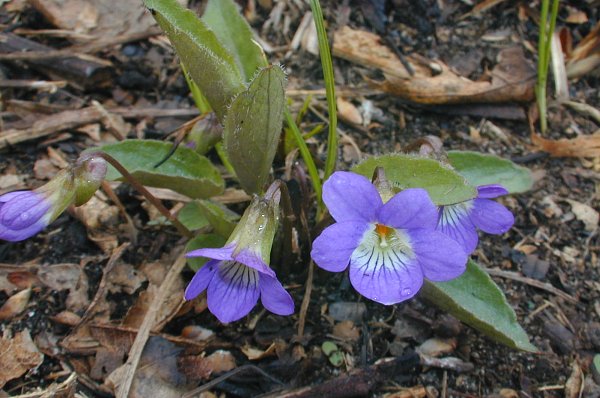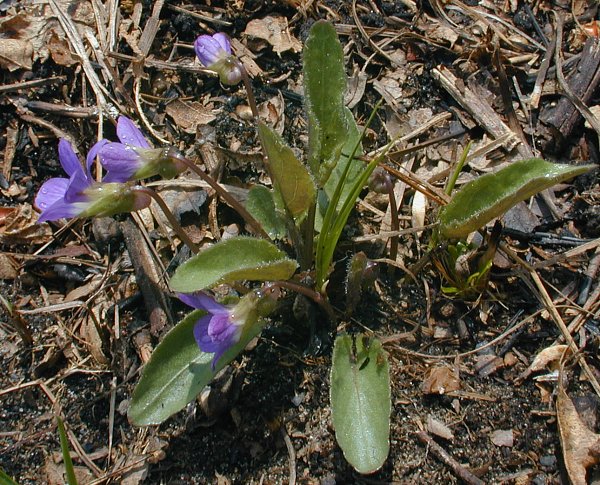Description: This perennial plant consists of a rosette of basal leaves about 5" across. The blade of each basal leaf is about 2" long and ¾" across; it is oval to ovate-oblong, crenate and ciliate along the margins, and more or less hairy, especially along the lower surface. The bottom of each leaf blade has tiny basal lobes that are rounded or bluntly pointed, while the tip of the leaf blade is rather blunt and obtuse. The leaf blade may fold upward along its central vein. The stout petiole of each leaf is green to reddish brown and hairy; it is as long as the leaf blade or a little shorter. From the center of the rosette, there develops one or stalks of flowers up to 6" long. These stalks develop directly from the rootstock; they are reddish purple and either glabrous or hairy. Each of these stalks is naked, except for a pair of tiny leaf-like bracts near the middle. At the apex of each stalk, there is a single flower about ¾" across. It consists of 5 green sepals and 5 blue-violet petals consisting of 2 upper lateral petals, 2 lower lateral petals, and a bottom petal. The sepals are lanceolate and glabrous or hairy. The lower lateral petals have conspicuous white hairs near the throat of the flower. The bottom petal is white at the base and it has dark blue-violet lines that function as nectar guides for visiting insects.

The blooming period occurs from
mid- to late spring and lasts about a month. There is no noticeable
floral scent. Flowers that are successfully cross-pollinated will
develop ovoid-oblongoid capsules that contain many seeds. Later,
self-fertile cleistogamous flowers will develop from erect or ascending
stalks; they lack petals and are inconspicuous. The cleistogamous
flowers also produce seed capsules. These capsules divide into 3 parts
at maturity, flinging the seeds. The seeds are small, globoid, and
brown. The root system consists of stout scaly rhizomes with
fibrous roots.
Cultivation:
The preference is full sun to light shade, moist to slightly dry
conditions, and sandy soil.

Range &
Habitat:
The native Sand Violet is occasional in sandy areas of central and
northern Illinois, otherwise it is rare or absent (see Distribution
Map). Habitats include sandy
woodlands, thinly wooded slopes, sandy savannas, sand prairies,
semi-shaded areas along sandy paths, and abandoned sandy fields.
Usually, this species is found in mesic to slightly dry areas of these
habitats. It benefits from occasional wildfires, as this reduces the
competition from taller vegetation.
Faunal Associations:
The nectar and/or pollen of the flowers attract honeybees, bumblebees,
long-horned bees (Synhalonia spp.), mason bees (Osmia spp.), Andrenine
bees, ants, bee flies (Bombylius spp.), butterflies, and skippers
(Robertson, 1929; Wilhelm & Rericha, 2017). Generally, the
nectar-seeking butterflies, skippers, and ants are less effective at
cross-pollination than many of the bees. The foliage of the Sand Violet
(Viola fimbriatula) and other violets (Viola spp.) is eaten by larvae
of the Variegated Fritillary (Euptoieta claudia), Aphrodite Fritillary
(Speyeria aphrodite), other Fritillary butterflies, and miscellaneous
moths. Other insects that feed on violets include the larvae of
leaf-mining flies, larvae of gall flies, larvae of sawflies, aphids,
and mealybugs (see Insect Table).
Vertebrate animals use violets as a food source to a limited extent.
The seeds of violets are eaten by the Mourning Dove, Slate-colored
Junco, Greater Prairie Chicken, and American Woodcock (Martin et al.,
1951/1961; Lewis, 1993). Both the Woodland Vole and White-footed Mouse
feed on the root crown and rhizomes of violets, while the Eastern
Chipmunk and Wood Turtle feed on the foliage (Martin et al., 1951/1961;
Wrazen & Svendsen, 1978; Ernst et al., 1994). Because the seeds
have oily coatings, they are distributed to new locations to some
extent by ants and possibly other insects.

Photographic
Location:
Along a path through a sandy savanna that had been subjected to a
recent wildfire in Kankakee County, Illinois.
Comments:
The Sand Violet (Viola
fimbriatula) is closely related to the Arrow-leaved Violet (Viola sagitatta), and it is classified as a variety of the latter
species, Viola sagitatta ovata,
by some authorities. The Sand Violet is usually hairier and its basal
leaves are more broad with blunt tips. The Arrow-leaved Violet has
basal leaves that are more lanceolate with spreading basal lobes (i.e.,
they are hastate in shape). The Arrow-leaved Violet occurs
throughout Illinois in both sandy and non-sandy habitats. Another
species, the Primrose-leaved Violet (Viola
primulifolia), has basal leaves that are similar in shape to
those of the Sand Violet, but its flowers are white. Sometimes this
latter species is regarded as a hybrid.